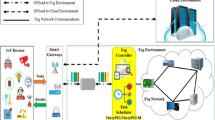Abstract
Cloud computing has indisputably emerged as the primary computing and storage platform for various contemporary workloads. These workloads, spanning from IoT to big data analytics and processing tasks, generate a vast number of daily tasks that require efficient mapping onto cloud resources. Consequently, developing a suitable task scheduling mechanism that minimizes execution delay and necessitates effective mapping onto cloud resources for efficient execution. To tackle this challenge, the study presents hybrid optimized Deep Reinforcement Learning-based scheduling approaches to efficiently manage huge workloads on cloud resources. These methods aim to minimize task waiting time and resource consumption, leading to improved performance in cloud computing environments. The proposed hybrid metaheuristic methods, which synergizes Particle Swarm Optimization, Firefly Algorithm, and Tabu Search with a mutation approach, is designed to improve task scheduling in IoT systems with resource-intensive requirements. By leveraging the strengths of these algorithms, the approach seeks to optimize resource utilization and enhance the efficiency of task scheduling in complex IoT environments. Simulation results demonstrate the effectiveness of the proposed hybrid methods compared to other approaches.



Similar content being viewed by others
Data Availability
Not applicable.
Code Availability
Not applicable.
References
Rjoub, G., Bentahar, J., Abdel Wahab, O., & Saleh Bataineh, A. (2021). Deep and reinforcement learning for automated task scheduling in large-scale cloud computing systems. Concurrency and Computation: Practice and Experience, 33(23), e5919.
Pal, S., Jhanjhi, N. Z., Abdulbaqi, A. S., Akila, D., Alsubaei, F. S., & Almazroi, A. A. (2023). An intelligent task scheduling model for hybrid internet of things and cloud environment for big data applications. Sustainability, 15(6), 5104.
Chen, W., Qiu, X., Cai, T., Dai, H. N., Zheng, Z., & Zhang, Y. (2021). Deep reinforcement learning for Internet of Things: A comprehensive survey. IEEE Communications Surveys & Tutorials, 23(3), 1659–1692.
Onwubolu, G. C., & Babu, B. V. (2013). New optimization techniques in engineering (Vol. 141). Springer.
Zhu, J., Song, Y., Jiang, D., & Song, H. (2017). A new deep-Q-learning-based transmission scheduling mechanism for the cognitive Internet of Things. IEEE Internet of Things Journal, 5(4), 2375–2385.
Xu, F., Yang, F., Bao, S., & Zhao, C. (2019). DQN inspired joint computing and caching resource allocation approach for software defined information-centric Internet of Things network. IEEE Access, 7, 61987–61996.
Alhartomi, M. (2023). New reward-clipping mechanism in deep-learning enabled internet of things in 6G to improve intelligent transmission scheduling. In 2023 IEEE 13th annual computing and communication workshop and conference (CCWC) (pp. 1236–1242). IEEE.
Shah, H. A., & Zhao, L. (2020). Multiagent deep-reinforcement-learning-based virtual resource allocation through network function virtualization in Internet of Things. IEEE Internet of Things Journal, 8(5), 3410–3421.
Liang, F., Yu, W., Liu, X., Griffith, D., & Golmie, N. (2021). Toward deep Q-network-based resource allocation in industrial internet of things. IEEE Internet of Things Journal, 9(12), 9138–9150.
Salh, A., Ngah, R., Hussain, G. A., Audah, L., Alhartomi, M., Abdullah, Q., Alsulami, R., Alzahrani, S., & Alzahmi, A. (2022). Intelligent resource management using multiagent double deep Q-networks to guarantee strict reliability and low latency in IoT network. IEEE Open Journal of the Communications Society, 3, 2245–2257.
Cheng, W., Liu, X., Wang, X., & Nie, G. (2022). Task offloading and resource allocation for industrial internet of things: A double-dueling deep Q-network approach. IEEE Access, 10, 103111–103120.
Saranya, N., Geetha, K., & Rajan, C. (2020). Data replication in mobile edge computing systems to reduce latency in internet of things. Wireless Personal Communications, 112(4), 2643–2662.
Zhao, X., & Wang, G. (2023). Deep Q networks-based optimization of emergency resource scheduling for urban public health events. Neural Computing and Applications, 35(12), 8823–8832.
Ge, Y., Wang, A., Zhao, Z., & Ye, J. (2019). A Tabu-genetic hybrid search algorithm for job-shop scheduling problem. In E3S web of conferences (Vol. 95, p. 04007). EDP Sciences.
Zhang, T., Zhang, Y. J., Zheng, Q. P., & Pardalos, P. M. (2011). A hybrid particle swarm optimization and tabu search algorithm for order planning problems of steel factories based on the make-to-stock and make-to-order management architecture. Journal of Industrial and Management Optimization, 7(1), 31.
Wang, Y. X., Xiang, Q. L., & Zhao, Z. D. (2010). Particle swarm optimizer with adaptive tabu and mutation: A unified framework for efficient mutation operators. ACM Transactions on Autonomous and Adaptive Systems (TAAS), 5(1), 1–27.
Kora, P., & Krishna, K. S. R. (2016). Hybrid firefly and particle swarm optimization algorithm for the detection of bundle branch block. International Journal of the Cardiovascular Academy, 2(1), 44–48.
Suganya, E., & Rajan, C. (2021). An adaboost-modified classifier using particle swarm optimization and stochastic diffusion search in wireless IoT networks. Wireless Networks (10220038), 27(4), 2287–2299.
Ezzeldin, R., Zelenakova, M., Abd-Elhamid, H. F., Pietrucha-Urbanik, K., & Elabd, S. (2023). Hybrid optimization algorithms of firefly with GA and PSO for the optimal design of water distribution networks. Water, 15(10), 1906.
Funding
Not applicable.
Author information
Authors and Affiliations
Corresponding author
Ethics declarations
Conflict of interest
The author declared that there is no conflict of interest.
Additional information
Publisher's Note
Springer Nature remains neutral with regard to jurisdictional claims in published maps and institutional affiliations.
Rights and permissions
Springer Nature or its licensor (e.g. a society or other partner) holds exclusive rights to this article under a publishing agreement with the author(s) or other rightsholder(s); author self-archiving of the accepted manuscript version of this article is solely governed by the terms of such publishing agreement and applicable law.
About this article
Cite this article
Shingne, H., Shriram, R. Mutated Deep Reinforcement Learning Scheduling in Cloud for Resource-Intensive IoT Systems. Wireless Pers Commun 132, 2143–2155 (2023). https://doi.org/10.1007/s11277-023-10709-5
Accepted:
Published:
Issue Date:
DOI: https://doi.org/10.1007/s11277-023-10709-5




